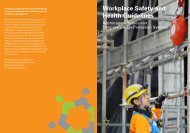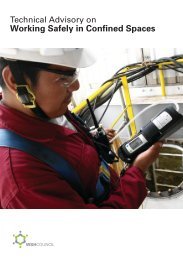here - Workplace Safety and Health Council
here - Workplace Safety and Health Council
here - Workplace Safety and Health Council
You also want an ePaper? Increase the reach of your titles
YUMPU automatically turns print PDFs into web optimized ePapers that Google loves.
10 WHAT’S NEW WHAT’S NEW 11<br />
Latest WSH INITIATIVES<br />
IMPORTANT UPDATES IN<br />
WSH (WORK AT HEIGHTS) REGULATIONS<br />
UPDATE ON WSH (WORK AT HEIGHTS) REGULATIONS 2013<br />
The WSH (Work at Heights) Regulations have been gazetted <strong>and</strong> are in effect from 1 May 2013. Currently<br />
applicable only to factories, coverage will be exp<strong>and</strong>ed to all workplaces in May 2014. Key provisions<br />
in the new Regulations include implementation of a fall prevention plan (FPP), permit-to-work (PTW)<br />
system, training of WAH personnel, safety provisions for working on roofs <strong>and</strong> fragile surfaces <strong>and</strong><br />
emphasis on using industrial rope access systems.<br />
The scope of coverage of the proposed Regulations is in two phases:<br />
1 May 2013 Regulations in effect <strong>and</strong> applicable only to factories<br />
1 May 2014 • Coverage will be exp<strong>and</strong>ed to all workplaces;<br />
• Establishment <strong>and</strong> implementation of FPP for specified workplaces; <strong>and</strong><br />
• Implementation of PTW system for work at heights w<strong>here</strong> a person could<br />
fall from a height of more than 3 metres.<br />
The WSH (Construction) Regulations have also been amended to delete those replica provisions in the new<br />
WSH (Work at Heights) Regulations via the WSH (Construction) (Amendment) Regulations 2013.<br />
RESOURCES AND ASSISTANCE FOR THE INDUSTRY<br />
To help industry get ready for the upcoming Regulations, the WSH <strong>Council</strong> has rolled out various capability<br />
building initiatives such as a revised Approved Code of Practice on Working Safely at Heights <strong>and</strong> an enhanced<br />
Construction <strong>Safety</strong> Orientation Course. To keep trainers up-to-mark on WAH fundamentals <strong>and</strong> ensure that<br />
they are competent to train others effectively, a new WAH Train-the-Trainer course was also developed. The<br />
increase from the current pool of 10 WAH accredited training providers in the coming months will translate to<br />
some 130,000 training places equipped to conduct the various WAH courses.<br />
REPEAL OF THE FACTORIES (PIC) AND<br />
FACTORIES (COC) REGULATIONS<br />
The Ministry of Manpower has two specific regulations to govern the operational safety of internal combustion<br />
engines (ICEs) <strong>and</strong> steam boilers (SBs); these regulations legislate the requirements of competent persons<br />
operating these machinery. Over the years, manual operations have advanced to using automation <strong>and</strong><br />
monitoring devices to ensure that ICEs <strong>and</strong> SBs operate within safe limits. Taking into consideration<br />
advancement in technology <strong>and</strong> the performance-based WSH Act, the Factories (Persons-in-Charge) Regulations<br />
<strong>and</strong> Factories (Certificate of Competency-Examination) Regulations will be revoked from 18 March 2013. The<br />
current WSH Act <strong>and</strong> its subsidiary legislation in place will ensure oversight on the safe operation of ICEs <strong>and</strong><br />
SBs at workplaces.<br />
NEW<br />
Publications<br />
The WSH <strong>Council</strong> recently issued five publications – the revised Approved Code of Practice on Working Safely at Heights, <strong>and</strong><br />
Activity Based Checklists. To view these publications in full, visit www.wshc.sg<br />
Code of Practice for<br />
Working Safely at Heights<br />
Safe Storage of Chemicals<br />
Improper <strong>and</strong> unsafe storage of chemicals can be hazardous to you <strong>and</strong> your workers. Use this basic checklist + as a guide to keep<br />
you <strong>and</strong> your workers safe. For more information on how you can keep your workplace safe, go to www.wshc.sg<br />
Name of Company Process/ Location<br />
Checked by (Name/ Designation) Date<br />
Chemicals are kept in<br />
closed containers when<br />
not in use.<br />
<strong>Safety</strong> Checks<br />
Chemicals <strong>and</strong> their<br />
containers are correctly<br />
labelled.<br />
Chemicals <strong>and</strong> their<br />
containers are stored<br />
properly (e.g., racks<br />
<strong>and</strong> cabinets) in wellventilated<br />
areas.<br />
<strong>Safety</strong> data sheets (SDS)<br />
are available for all the<br />
chemicals stored.<br />
Workers are prohibited<br />
from smoking in areas<br />
w<strong>here</strong> flammable<br />
chemicals are stored.<br />
Containment materials<br />
such as absorbents are<br />
available.<br />
Fire extinguishers on site<br />
are not expired.<br />
Combustibles (e.g.,<br />
papers <strong>and</strong> cloths) are<br />
removed or stored away<br />
from the chemical storage<br />
area.<br />
+ This checklist may not cover a l aspects of work activities in your workplace. You should review the checklist when t<strong>here</strong> are changes in any work activity.<br />
* NA – Not applicable<br />
Please tick ( 3)<br />
Yes No NA*<br />
If no, action required by:<br />
Name :<br />
Date :<br />
Name :<br />
Date :<br />
Name :<br />
Date :<br />
Name :<br />
Date :<br />
Name :<br />
Date :<br />
Name :<br />
Date :<br />
Name :<br />
Date :<br />
Name :<br />
Date :<br />
Revised Approved Code of Practice for Working Safely at Heights<br />
To support industry’s compliance of the new Work at Heights Regulations 2013,<br />
this revised edition of the Approved Code of Practice (ACOP) for Working Safely<br />
at Heights now includes guidance on implementing fall prevention plans<br />
<strong>and</strong> permit-to-work systems for working at heights, <strong>and</strong> provides further<br />
elaboration of key statutory requirements. This ACOP applies to work at<br />
heights activities across all industry sectors.<br />
Activity Based Checklists<br />
Designed as a simple <strong>and</strong> practical safety guide for use onsite, the<br />
checklists can be used by workers <strong>and</strong> supervisors to help keep all parties<br />
safe. The checklists include various work activities such as “Safe Storage of<br />
Chemicals”, “Working Safely at Heights”, “Working Safely with Machines”<br />
<strong>and</strong> “Working Safely with Non-powered H<strong>and</strong> Tools”.<br />
Openings into or<br />
through which a person<br />
may fall are covered or<br />
guarded with effective<br />
barriers.<br />
Working Safely at Heights<br />
Falls from heights are a major cause of work-related fatalities <strong>and</strong> injuries. It is important to ensure <strong>and</strong> maintain a safe work<br />
environment for working at heights. Use this checklist + as a guide to keep you <strong>and</strong> your workers safe. For more information on<br />
how you can keep your workplace safe, go to www.wshc.sg<br />
<strong>Safety</strong> Checks<br />
T<strong>here</strong> are h<strong>and</strong>rails <strong>and</strong><br />
lower rails at open sides<br />
of staircases.<br />
Guardrails are put in place<br />
to prevent people from<br />
falling over the edge.<br />
Working platforms used<br />
are certified, of sound<br />
construction <strong>and</strong> are<br />
able to support the<br />
worker’s weight.<br />
Safe means of access <strong>and</strong><br />
egress are provided.<br />
Workers are provided<br />
with personal fall arrest<br />
systems with sufficient<br />
<strong>and</strong> secured anchorages.<br />
Good housekeeping<br />
is practised to prevent<br />
falls from heights due to<br />
tripping hazards.<br />
An appointed <strong>and</strong><br />
competent supervisor<br />
oversees workers working<br />
at heights.<br />
+ This checklist may not cover a l aspects of work activities in your workplace. You should review the checklist when t<strong>here</strong> are changes in any work activity.<br />
* NA – Not applicable<br />
Please tick ( 3)<br />
Yes No NA*<br />
Name of Company Process/ Location<br />
Checked by (Name/ Designation) Date<br />
If no, action required by:<br />
Name :<br />
Date :<br />
Name :<br />
Date :<br />
Name :<br />
Date :<br />
Name :<br />
Date :<br />
Name :<br />
Date :<br />
Name :<br />
Date :<br />
Name :<br />
Date :<br />
Name :<br />
Date :<br />
Working Safely with Machines<br />
Working with machines will expose you <strong>and</strong> your workers to risks which can lead to serious bodily injuries. Use this basic checklist +<br />
as a guide to keep you <strong>and</strong> your workers safe. For more information on how you can keep your workplace safe, go to www.wshc.sg<br />
Name of Company Process/ Location<br />
Checked by (Name/ Designation) Date<br />
<strong>Safety</strong> Checks<br />
Emergency shutdown<br />
switch for each machine<br />
is within operator’s reach.<br />
Machine guard is<br />
installed on moving<br />
parts of machine.<br />
Workers check for<br />
irregularities on machine<br />
before operation.<br />
Workers are briefed on<br />
the hazards <strong>and</strong> risks of<br />
working with machines.<br />
Workers wear earplugs<br />
when working with<br />
noisy machines.<br />
Workers’ clothes are fitted<br />
<strong>and</strong> their long hair is tied<br />
to prevent either from<br />
being caught in machines.<br />
Good housekeeping is<br />
maintained in machine<br />
area.<br />
Work area is well-lit.<br />
+ This checklist may not cover a l aspects of work activities in your workplace. You should review the checklist when t<strong>here</strong> are changes in any work activity.<br />
* NA – Not applicable<br />
Please tick ( 3)<br />
Yes No NA*<br />
If no, action required by:<br />
Name :<br />
Date :<br />
Name :<br />
Date :<br />
Name :<br />
Date :<br />
Name :<br />
Date :<br />
Name :<br />
Date :<br />
Name :<br />
Date :<br />
Name :<br />
Date :<br />
Name :<br />
Date :<br />
Working Safely with<br />
Non-powered H<strong>and</strong> Tools<br />
Using the wrong tools or the correc tools incorrectly to perform a task can cause injuries. Use this basic checklist + as a guide to<br />
keep you <strong>and</strong> your workers safe. For more information on how you can keep your workplace safe, go to www.wshc.sg<br />
Name of Company Process/ Location<br />
Checked by (Name/ Designation) Date<br />
Damaged tools are<br />
replaced.<br />
<strong>Safety</strong> Checks<br />
Workers keep tools <strong>and</strong><br />
h<strong>and</strong>s clean <strong>and</strong> free<br />
from grease.<br />
Workers are briefed on<br />
the hazards <strong>and</strong> risks of<br />
the job.<br />
Workers are trained to<br />
use tools correctly.<br />
Workers wear safety<br />
goggles to protect<br />
their eyes from flying<br />
particles.<br />
Workers wear safety<br />
shoes.<br />
Tools are stored properly<br />
in their correct places.<br />
+ This checklist may not cover a l aspects of work activities in your workplace. You should review the checklist when t<strong>here</strong> are changes in any work activity.<br />
* NA – Not applicable<br />
Please tick ( 3)<br />
Yes No NA*<br />
If no, action required by:<br />
Name :<br />
Date :<br />
Name :<br />
Date :<br />
Name :<br />
Date :<br />
Name :<br />
Date :<br />
Name :<br />
Date :<br />
Name :<br />
Date :<br />
Name :<br />
Date :

















